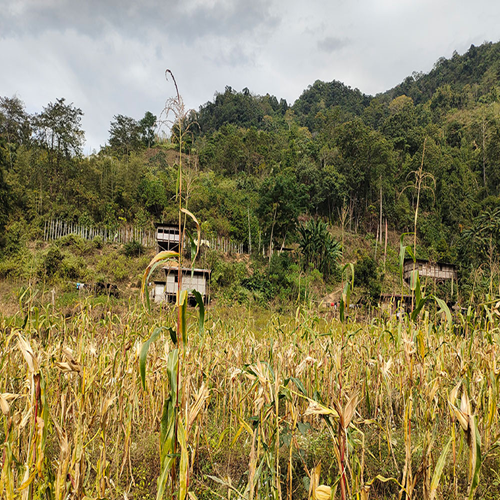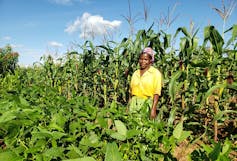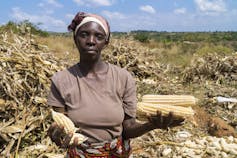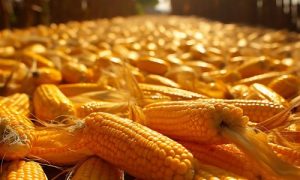Malawi farming experiment shows how simple changes can boost maize yields and improve soil

Malawi’s smallholder farmers are tackling climate challenges with innovative methods. Research shows that combining maize with cowpea and pigeon pea in deep beds significantly boosts soil fertility and yields, outperforming traditional fertilisers. Intercropping and deep bed farming, supported by NGO Tiyeni, have enhanced soil nitrogen and phosphate levels, leading to higher maize production. This cost-effective approach improves food security, reduces dependence on expensive fertilisers, and combats soil erosion, crucial for climate resilience.
Malawi’s increasingly unpredictable rainfall and higher than usual temperatures are causing problems for smallholder farmers. Soil erosion has increased, causing soil fertility and water availability to decline. Crops often fail.
Farmers are already struggling financially. Many farm only one crop: maize. They can’t easily afford chemical fertilisers that would boost the soil’s fertility and sustain yields.
Agriculture accounts for just over 25% of Malawi’s gross domestic product. About 80% of the population depend on smallholder farming for their survival.
We are soil fertility and sustainable development specialists. Together with sustainable agriculture and environmental researcher Augustine Talababie Phiri, we set out to discover how we could use different combinations of plants to improve soil fertility so that farmers wouldn’t need expensive fertilisers.

We conducted trials on farms in northern Malawi where we tested a combination of different crops grown together. We then measured changes to the soil fertility in each field over a two year period.
Our research found that growing maize with cowpea and pigeon pea in raised “deep beds” led to much greater soil fertility.
What we researched
Traditional farming techniques involve tilling the soil each year and then planting and cultivating one crop on narrow ridges. However, these ridges are extremely vulnerable to soil erosion.
We looked into the results of combining intercropping with deep bed farming. Intercropping means growing two or more crops side by side, instead of just one. Deep bed farming is a new practice developed in Malawi where a farmer digs with a pickaxe all the way through the hard layer of soil near the surface. This hard layer – the compacted soil hardpan – prevents plant roots from growing well, and usually stunts the growth of the crop. Breaking it up allows the crop roots more room to grow.
The other part of deep bed farming involves planting seedlings on piles of soil 30cm higher than ground level. The farmer then digs a ditch next to these beds to catch and hold rainwater, and keep the soil moist for months.
We worked with a Malawi non-governmental organisation, Tiyeni, which has been training farmers in sustainable and climate-smart agriculture since 2004. Tiyeni had found that the maize yield from deep beds was much higher than maize grown the normal way.
We decided to work with smallholder farmers in Msongwe, near the city of Mzuzu, to see if intercropping peas with maize in deep beds would give even better results.
Our experimental design compared agricultural plots across two growing seasons, one after another. We tried growing different combinations of maize in traditional cultivation ridges (ordinarily sown in lines) and in deep beds, both on its own and intercropped with cowpea or pigeon pea. We then analysed the amount of nitrates in the soil – one of the most important nutrients to help plants grow. We also analysed the amount of phosphates (or phosphorous, another important nutrient) in the soil and measured the amount of maize that was grown.
Inexpensive climate-smart solutions
Our research found that intercropping improves the soil a lot. Legumes such as beans or peas take nitrogen from the atmosphere and turn it into ammonium and nitrate in the soil. This is a natural fertiliser. It improves soil health and supports better growth for other crops, like maize, that are planted alongside legumes.
When cereal-legume intercropping is combined with deep bed farming, the results are even better. We found that:

Soil is more fertile: The nitrogen-fixing ability of pigeon pea and cowpea enriched the soil even more than ordinary fertilisers did. In the test areas with deep bed farming, the soil fertility improved even more and remained very fertile across the two growing seasons.
Crops produce more: Intercropping with legumes showed higher crop yields compared to the fields where only maize was grown. Again, these effects were higher in the deep bed farming fields across the two growing seasons.
Why this matters
This new method of farming improves the quality of the soil and its ability to grow more crops.
Farmers can reduce their dependence on chemical fertilisers, which are often expensive and out of reach. This makes farming more sustainable and cost-effective.
Higher yields of maize, cowpea and pigeon pea mean a greater quantity and diversity of nutritious food can be produced on the same amount of land.
Because farmers don’t have to buy fertilisers, their profits are greater and it costs less to grow more crops to sell. Farmers used these profits for many different things, from paying school fees to investing in business enterprises.
Deep bed farming reduces soil erosion and compaction. When soil is compacted, or pressed together too tightly, it does not retain water. This is important in Malawi, which has suffered a number of El Niño droughts. The natural nitrogen-fixing process of legumes also reduces the environmental impacts of farming.
In short, combining deep bed farming with legume intercropping can enhance the benefits already being achieved by both systems independently. As climate change continues to negatively affect agriculture worldwide, innovative approaches like these will be essential in creating more resilient and productive agricultural systems.
Source Link : https://theconversation.com/malawi-farming-experiment-shows-how-simple-changes-can-boost-maize-yields-and-improve-soil-231520
















